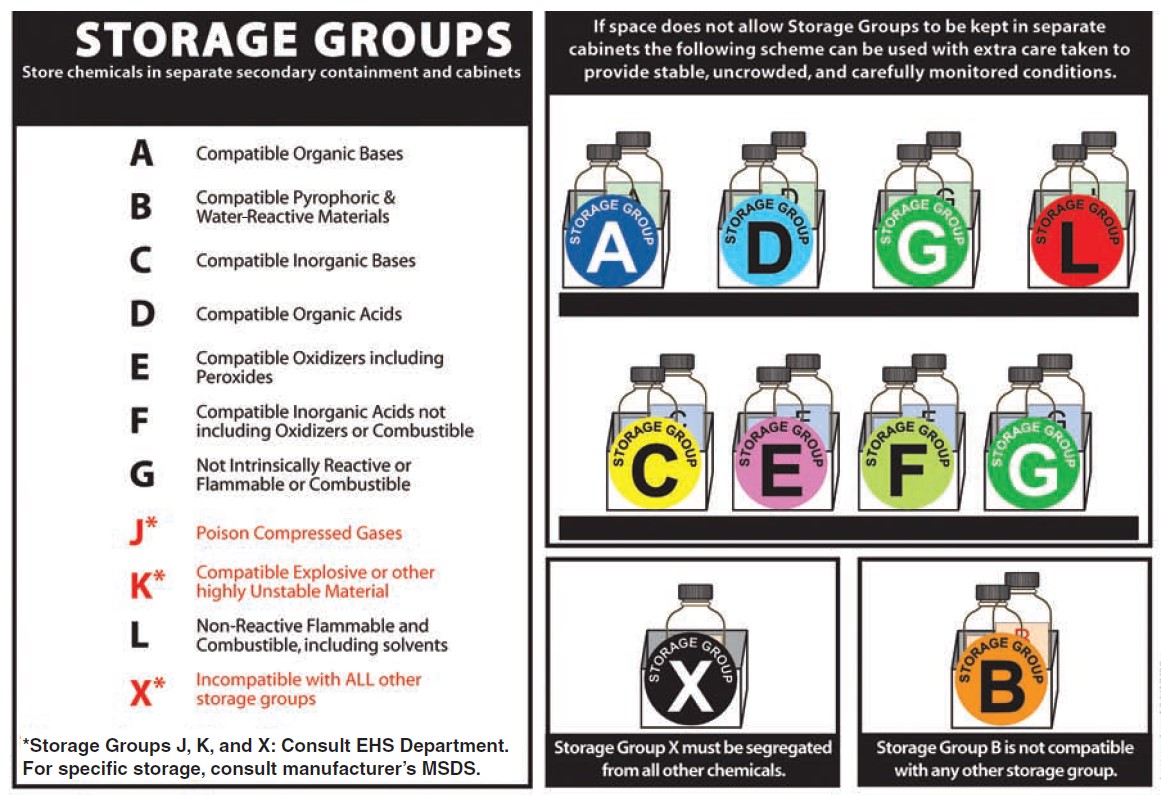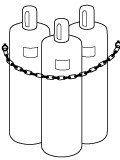Chemical Storage
The primary objective when storing chemicals is to minimize the physical and chemical hazards associated with certain stock chemicals and with the accidental mixing of chemicals due to fire, earthquake, accidental breakage, or other laboratory accident. Assessment of these hazards must also consider the mixing of fugitive vapors from volatile compounds which can lead to destruction of containment vessels or potentially explosive conditions.
General considerations
The following guidelines are applicable to the storage of all types of chemicals:
- Chemicals should never be stored directly on the floor.
- Keep chemicals off of work area countertops when not in immediate use.
- Do not store chemicals in fume hoods unless required. Crowding within a fume hood results in decreased hood performance, lead to lab accidents, or may be prohibited by regulation (e.g., open volatile containers are prohibited).
- Label all chemicals with the purchase date to maintain inventory control.
- Store chemicals inside a closed cabinet or shelf with a lip to avoid accidental breakage.
- Position shelves to remove tallest container in an upright position. Avoid having to tilt container to access it.
- Store flammable liquids in approved flammable-liquid storage cabinets.
- Store chemicals according to compatible storage groups
- Do not store food in refrigerators or freezers used for chemical, biological or radioisotope storage. Refrigerators and freezers must be labeled "NO FOOD – CHEMICALS ONLY" or "NO CHEMICALS - FOOD ONLY" depending on the intended purpose of the equipment. Labels are available from EHS.
Chemical storage groups
There are many systems for segregating chemicals into groups compatible for storage and this is only one of them. This system is recommended for use across KSU laboratory spaces for its conservative approach to safety and minimal laboratory expertise required by laboratory personnel to properly execute this system. The drawback of this system is that several separate chemical storage locations are required which may not be feasible in some small laboratory spaces. In these instances, other segregation systems may be used (such as Fisher Scientific’s ChemAlert color system). Contact EHS for assistance.
Ten incompatible storage groups are identified in Prudent Practices in the Laboratory: Handling and Management of Chemical Hazards. Ideally, these groups would each be stored in a separate cabinet, but at a minimum they must be separated by suitable secondary storage containers. In addition to the categories outlined in Figure 2 , check SDSs for storage incompatibilities of specific chemicals. Additional incompatibilities are listed in Appendix A: Chemical Compatibility List .

Figure 2 – Compatible storage group classification system. In addition to these categories, check manufacturers SDS for specific storage incompatibilities (From Prudent Practices in the Laboratory, adapted from Stanford University’s ChemTracker Storage System).
Some of these storage groups will require special storage conditions in addition to being separated from other chemicals. For information on pyrophorics, peroxides, and other highly unstable chemicals, see Specific Hazards.
Chemicals in Storage Group X are highly reactive, highly toxic, or some combination of the two and should be stored by themselves instead of collected in a group. Some examples include picric acid, phosphorous, sodium azide (not in solution), and sodium hydrogen sulfide.
Flammable Liquids
Flammable liquid storage is regulated by volume and the flashpoint of the chemicals. These chemicals should be stored in a flammables cabinet, or an explosion-proof or flammable-safe refrigerator at all times. No more than 5 gallons per laboratory of flammable chemicals may be stored outside of a cabinet at one time. Flammables storage cabinets must meet International Fire Code standards, including:
- Made of flame resistant material
- Labelled: FLAMMABLE – KEEP FIRE AWAY
- Well fitted, self-closing doors equipped with three-point latch
- Bottom of cabinet shall be liquid tight to a height of at least two inches
Radioactive Materials
Containers of radioactive material shall have a firmly affixed durable, clearly visible label bearing the radiation symbol and the words CAUTION (or DANGER) RADIOACTIVE MATERIAL. Labels on storage containers shall also state the quantities and kinds of radioactive materials and date of measurement. Radioactive material should be stored in a locked container within a locked room. Reasonable protection shall be provided against loss or leakage by the effects of fire or water.
Equipment used with radioactive materials such as glassware shall be kept separate from other equipment. Once used with radioisotopes, the equipment shall not be used for other work or shall not be sent for repair or glass washing area until demonstrated to be free of contamination. A storage cabinet marked with an official radiation symbol must be provided for glassware and tools used in radioisotope work.
Compressed Gases
Each tank must be properly and permanently identified when received. Never accept a cylinder on which the name of the contents is illegible. Do not rely on color codes for tank identification. Cylinder labels and/or marking must spell out the content name. Store cylinders with the content label readily visible. Use appropriate regulators and do not attempt to modify or change cylinder valves or regulators.
Only those gas cylinders in immediate use shall be located in a laboratory. Replacement cylinders and empty cylinders shall be stored in a designated area, preferably outside the building. Do not store cylinders in hallways. Transport cylinders using a proper dolly with cylinder securing apparatuses. Tightly secure threaded caps prior to moving cylinders.
All compressed gas cylinders must be secured with a chain, clamp, or strap at all times when in use, storage, or transport. Three points of contact should be made with the sides of the cylinder at all times whether in transit, storage, or use. When not in use or while in transit, regulators shall be removed and valve protection caps put in place.

Figure 3 - example of proper three points of contact while storing gas cylinders
Use all of the contents of a cylinder whenever possible. Even though the cylinder may seem empty, continue to use recommended handling procedures for compressed gas cylinders. Return the empty cylinder to the manufacturer, if possible. Cylinders that cannot be returned and are empty or are no longer wanted are handled through the hazardous waste program.
See Pressure Vessels .
Peroxide Forming Chemicals
Peroxide forming chemicals have the potential to form peroxide crystals under normal storage conditions. These crystals are highly reactive and may explode upon ignition by mechanical forces such as unscrewing the lid of the container. To avoid this situation, follow these guidelines:
- All laboratories working with peroxide forming chemicals (PFC) must maintain an inventory control program for PFC to ensure these chemicals are removed from inventory as indicated, examined for signs of potential peroxides, and/or tested for peroxides.
- Order only quantities necessary to complete an experiment and that will be used up within six months or less.
- Purchase PFCs with added peroxide formation inhibitor, whenever possible.
- PFCs must be appropriately labelled, including the date opened and expiration date as according to manufacturer. Expired chemicals must be promptly disposed of by EHS as hazardous waste.
- Document on label the dates of peroxide testing and additions of inhibitors.